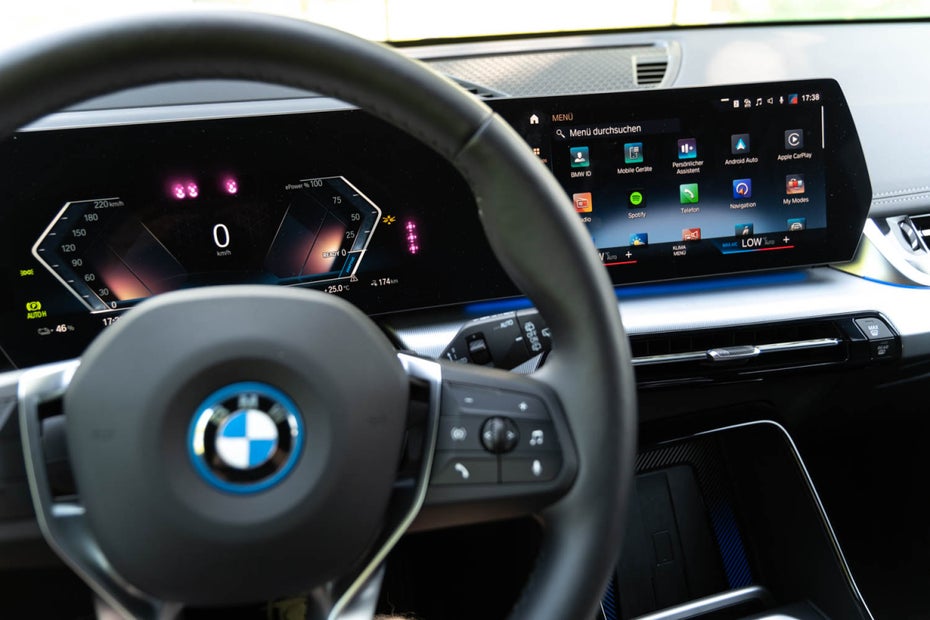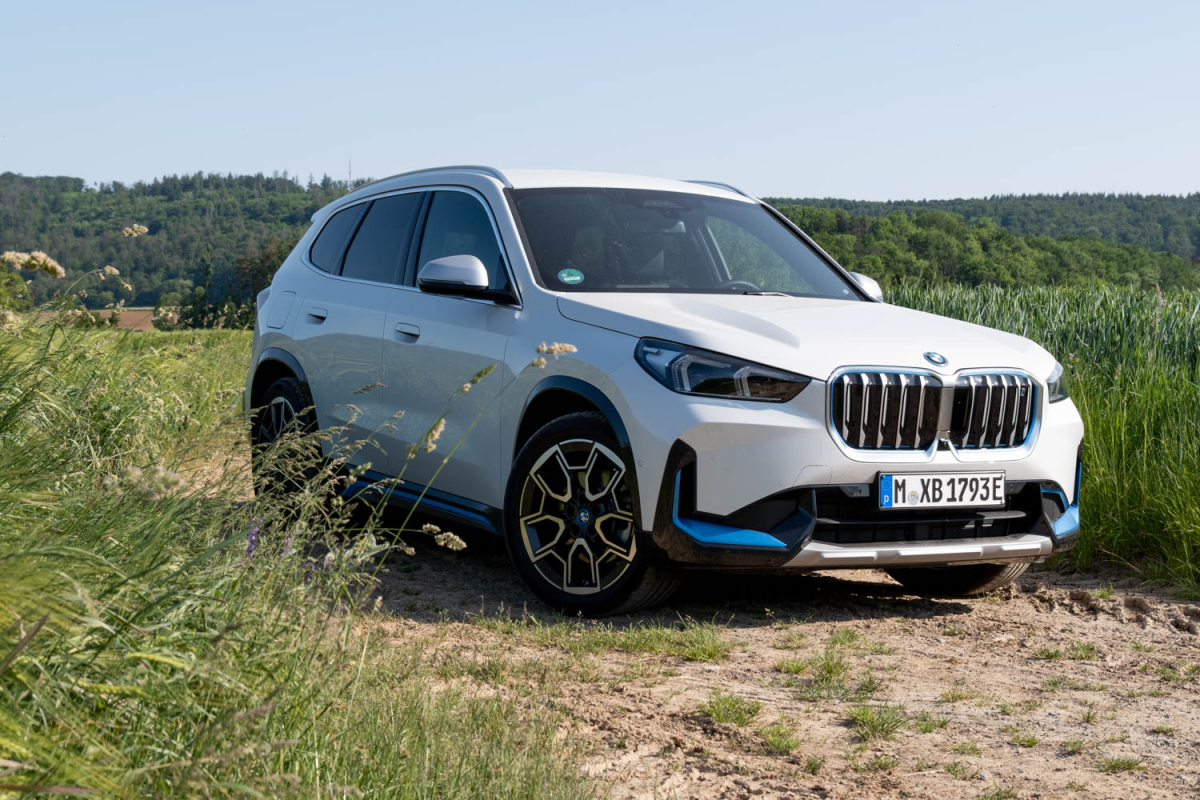Dynamic compact SUV with lots of space
It is now well known that BMW builds excellent electric cars. The BMW i3, which appeared ten years ago, is still considered an icon of electromobility. After that, it was quiet for a while about the Munich company and some thought that BMW had missed the connection with the drive turnaround. But at the latest with the BMW iX, the company then proved that it is still capable of building first-class electric cars.
Unlike many other manufacturers, however, BMW then decided to go its own way. For example, while VW and Mercedes-Benz rely on dedicated platforms for their all-electric models, BMW uses a modular platform. That means: There is a model, such as the X1 or the 7 Series, as a petrol, diesel, plug-in hybrid and electric car. The fully electric models are only additionally marked with an i (iX1, i7).
In our two-week test, we looked at whether the BMW iX1 can keep up with the competition despite the mixed platform.
Most brands offer their electric cars with several engines, which often go hand in hand with different battery capacities. Depending on the model, this makes sense, because not everyone needs an 80-kilowatt hour battery with a gigantic range, all-wheel drive or 500 hp.
However, BMW has decided to only offer one motorization for the iX1, at least for the moment. The BMW iX1 xDrive30 has a 64.7 kilowatt hour battery and a system output of 230 kilowatts (313 hp). The compact SUV accelerates from 0 to 100 km/h in 5.6 seconds and has an electric range of up to 439 kilometers in the WLTP test cycle. The maximum charging capacity is 130 kilowatts.
The basic model with fairly spartan equipment costs almost exactly 55,000 euros – and the list of extras is long. If you opt for a somewhat more dynamic exterior, leather interior and technical extras such as adaptive LED headlights, high-beam assistant, heated seats, high-quality speakers and a panoramic glass roof, you can easily crack the 70,000 euros.
That may still be acceptable by BMW standards, but compared to other electric cars in this category, the BMX iX1 is definitely one of the most expensive.
Plenty of space: Despite the compact design, the trunk of the BMW iX1 holds 490 liters. (Photo: Frank Feil)
When you sit behind the wheel of the iX1 for the first time, you know immediately that you are sitting in a BMW. Both the choice of materials and the workmanship are first class. Everything is harmonious and you feel right at home. Also worth mentioning is the trunk, which has a volume of 490 liters. If you consider that the iX1 is only 4.50 meters long, that is quite a considerable capacity.
While driving, the iX1 presents itself in typical BMW fashion: the chassis is comfortable, but at the same time sporty. While many SUVs don’t cut a good figure when you’re going a little faster in a curve, the BMW is safe on the road. This is of course also due to the fact that the iX1 can switch from front to all-wheel drive depending on the situation.
Similar to the i7 and iX, the iX1 largely dispenses with physical switches and buttons. Almost everything can be operated intuitively and easily via the frameless BMW Curved Display with touch and voice control. This works perfectly in our test. If you want, you can of course also use Apple Carplay or Android Auto.
If you consider that a Smart #1 or a Kia EV6 can sprint from 0 to 100 km/h in under four seconds, the 5.6 seconds of the iX1 seem downright leisurely – and yet they are really enough for every conceivable situation in everyday life completely off. And BMW has also achieved the perfect balance when it comes to recuperation: either you opt for adaptive recuperation (driving level D), or you switch directly to B. Then real one-pedal driving is possible, which many people already do on the BMW i3 appreciated.


The interior of the BMW iX1 scores with high-quality materials and first-class workmanship. (Photo: Frank Feil)
Although the BMX iX1 is often referred to as a “converted combustion engine”, the Munich-based company has succeeded in creating an extremely efficient electric car. In our test, consumption was between 17.5 and 20 kilowatt hours per 100 kilometers, depending on driving style and route profile. Of course, this can sometimes be higher in winter, but all in all there is nothing to complain about in this regard.
With regard to the range, between 320 and 380 kilometers are realistic with these consumptions. While that doesn’t necessarily make the iX1 the perfect car for field workers, most people should be fine with it on a day-to-day basis.
Meanwhile, BMW could have been a little more ambitious when it came to charging capacity. 130 kilowatts are no longer really up-to-date in the premium segment, especially since these are only kept up to about 40 percent SoC (state of charge). At around 60 percent SoC, the charging capacity falls below 100 kilowatts. The only reason why BMW can claim a charging time of 29 minutes on the fast charger is the comparatively small battery. At least 170 kilowatts would have been desirable here, especially when you consider that Kia and Hyundai charge with 220 kilowatts.

The BMW iX1 is extremely efficient, but the maximum charging capacity of 130 kilowatts leaves a lot to be desired. (Photo: Frank Feil)
Basically, the BMW iX1 is a successful electric car that offers a lot of space despite its compact external dimensions. Above all, the trunk volume of 490 liters (and almost 1,500 liters with the rear seat folded down) is positive to mention in this context.
There is nothing to complain about either in terms of driving comfort or the choice of materials and workmanship. Everything meets BMW’s premium standards. The same applies to the infotainment system and the numerous available assistance systems.
Our original fear that the BMW iX1 could suffer from the mixed platform was also not confirmed in the test. The compact SUV presents itself as a consistently efficient electric car that doesn’t have to hide from the competition when it comes to electric driving fun. Many people who primarily use the iX1 for shorter distances will be able to overlook the comparatively low charging capacity.
However, there is one catch: the decision to have a motor and a battery – and the associated high entry price. If you want an iX1, you (currently) have to go for the iX1 xDrive30. With a system output of 230 kilowatts (313 hp) and all-wheel drive, this is overpowered for some. Others ask themselves why they should spend up to 70,000 euros for a well-equipped iX1 when they can get a significantly more spacious Tesla Model Y Performance with 377 kilowatts (513 hp) from 61,000 euros.
And that is exactly what makes the iX1 an electric car that is primarily of interest to BMW fans. If you had the old X1 and now want to switch to an electric car, you will definitely order an iX1 from your trusted BMW dealer. Everyone else will think twice about whether the BMW logo on the hood is really worth that much money.



